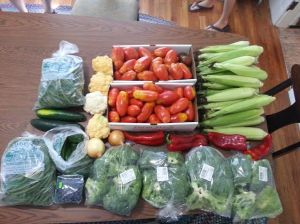I am now almost two weeks into my local eating challenge and I have yet to explain it, so here goes. As you know, my YAV year is centered around food justice. Food justice has a lot of components, many of which have to do with the consumer. Ex- getting healthy, reliable food; teaching people what is healthy food and what is just filling. But there is another huge part of food justice that is so easy to ignore and it can be boiled down to one simple question- Where does your food come from?
Does this seem like a silly question? How would you answer me if I walked into your kitchen and asked where your food comes from? Would you tell me which grocery store you go to? Or maybe you’d tell me that apples grow on trees? That’s a little closer to the answer I’m looking for. Where, specifically, does each ingredient that you just bought, come from? Here’s an uncomfortable fact- “Each food item in a typical U.S. meal has traveled an average of 1,500 miles” (Hopp, Animal, Vegetable, Miracle).Stephen L. Hopp goes on to say “If every U.S. citizen ate just one meal a week (any meal) composed of locally and organically raised meats and produce, we would reduce our country’s oil consumption by over 1.1 million barrels of oil every week.” In times where we complain about our daily commute (I know I hate those big trucks on the road) and gas prices, why is no one talking about how much we’re spending on our food? I think we all know that pineapples don’t grow in 99% of America- especially in December. So why do we buy them? Believe me, I appreciate the delicious fruits that have become common place in our grocery store, but we have to admit that things are better in their right season, in their right space.
All of this brings me back to the question ‘where does your food come from?’ For me, until January 31st 2016, my food with be coming from New England. The local eating challenge that my two roommate and I have undertaken has one simple rule: eat local. And local means EVERYTHING local. As you can guess, I wont be having any pineapple for a while, but let me tell you what I will be having. So many apples, peaches and pears. Raspberries. Cranberries. Carrots. Onions. Every type of pepper you can imagine. Spinach. Lettuce. Tomatoes. All the potatoes. Summer squash is on its way out, but that just means that winter squash is on its way in! Broccoli. Mushrooms. Corn. Eggs, butter, and milk. There is local wheat, so we can bake our own bread and make out own pasta. The list goes on and on. For those of you that were thinking New England is a frozen tundra and can’t grow enough to survive, you’re not alone. I thought the same thing until I went to Hutchins Farm and saw that literally every thing they sell comes out of the farm on the other side of the store. Which means that my money will be going into the farmers pocket (but that’s a topic for another post). If this all sounds crazy to you, look up a farmers market in your area and go take a look. I think you’ll find the prices are fair and the food is delicious.

